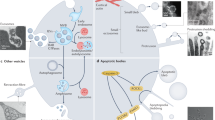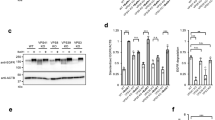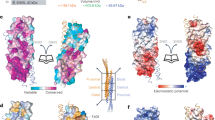Abstract
Protein secretion and the transport of proteins between membrane-bound compartments are mediated by small, membrane-bound vesicles. Here I review what is known about the process by which vesicles are targeted to the correct destination. A growing family of proteins, whose precise modes of action are far from established, is involved in targeting. Despite the wide diversity in the identities of the players, some common themes are emerging that may explain how vesicles can identify their targets and release their cargo at the correct time and place in eukaryotic cells.
This is a preview of subscription content, access via your institution
Access options
Subscribe to this journal
Receive 12 print issues and online access
$209.00 per year
only $17.42 per issue
Buy this article
- Purchase on Springer Link
- Instant access to full article PDF
Prices may be subject to local taxes which are calculated during checkout


Similar content being viewed by others
References
Rothman, J. E. Mechanisms of intracellular protein transport. Nature 372, 55–63 (1994).
Scheller, R. H. Membrane trafficking in the presynaptic nerve terminal. Neuron 14, 893–897 ( 1995).
Südhof, T. C. The synaptic vesicle cycle: a cascade of protein–protein interactions. Nature 375, 645–653 (1995).
Nichols, B. J. & Pelham, H. R. SNAREs and membrane fusion in the Golgi apparatus. Biochim. Biophys. Acta 1404, 9–31 (1998).
Ferro-Novick, S. & Jahn, R. Vesicle fusion from yeast to man. Nature 370, 191– 193 (1994).
Montecucco, C. & Schiavo, G. Structure and function of tetanus and botulinum neurotoxins. Quart. Rev. Biophys. 28, 423–472 (1995).
Hayashi, T. et al. Synaptic vesicle membrane fusion complex: action of clostridial neurotoxins on assembly. EMBO J. 13, 5051 –5061 (1994).
Weis, W. I. & Scheller, R. H. SNARE the rod, coil the complex. Nature 395, 328–329 (1998).
Rizo, J. & Südhof, T. C. Mechanics of membrane fusion. Nature Struct. Biol. 5, 839– 842 (1998).
Hughson, F. M. Membrane fusion: structure snared at last. Curr. Biol. 9, R49–R52 (1999).
Weber, T. et al. SNAREpins: minimal machinery for membrane fusion. Cell 92, 759–772 ( 1998).
Nicholson, K. L. et al. Regulation of SNARE complex assembly by an N-terminal domain of the t-SNARE, Sso1p. Nature Struct. Biol. 5, 793–802 (1998).
Lian, J. P., Stone, S., Jiang, Y., Lyons, P. & Ferro-Novick, S. Ypt1p implicated in v-SNARE activation. Nature 372, 698–701 ( 1994).
Søgaard, M. et al. A rab protein is required for the assembly of SNARE complexes in the docking of transport vesicles. Cell 78, 937–948 (1994).
Lupashin, V. V. & Waters, M. G. t-SNARE activation through transient interaction with a rab-like guanosine triphosphatase. Science 276, 1255–1258 ( 1997).
Pfeffer, S. R. Transport vesicle docking: SNAREs and associates. Annu. Rev. Cell Dev.Biol. 12, 441–461 ( 1996).
Pevsner, J. et al. Specificity and regulation of a synaptic vesicle docking complex. Neuron 13, 353–361 (1994).
Butz, S., Okamoto, M. & Südhof, T. C. A tripartite protein complex with the potential to couple synaptic vesicle exocytosis to cell adhesion in brain. Cell 94, 773–782 ( 1998).
Hayashi, T., Yamasaki, S., Nauenburg, S., Binz, T. & Niemann, H. Disassembly of the reconstituted synaptic vesicle membrane fusion complex in vitro. EMBO J. 14, 2317–2325 ( 1995).
Hunt, J. M. et al. A post-docking role for synaptobrevin in synaptic vesicle fusion. Neuron 12, 1269– 1279 (1994).
Broadie, K. et al. Syntaxin and synaptobrevin function downstream of vesicle docking in Drosophila. Neuron 15, 663–673 (1995).
Schiavo, G., Stenbeck, G., Rothman, J. E. & Sollner, T. H. Binding of the synaptic vesicle v-SNARE, synaptotagmin, to the plasma membrane t-SNARE, SNAP-25, can explain docked vesicles at neurotoxin-treated synapses. Proc. Natl Acad. Sci. USA 94, 997– 1001 (1997).
Hanson, P. I., Heuser, J.E. & Jahn, R. Neurotransmitter release — four years of SNARE complexes. Curr. Opin. Neurobiol. 7, 310 –315 (1997).
Garcia, E. P., McPherson, P. S., Chilcote, T. J., Takei, K. & DeCamilli, P. rb Sec1A and B colocalize with syntaxin 1 and SNAP-25 throughout the axon, but are not in a stable complex with syntaxin. J. Cell Biol. 129, 105– 120 (1995).
von Mollard, G. F., Nothwehr, S. F. & Stevens, T. H. The yeast v-SNARE Vti1p mediates two vesicle transport pathways through interactions with the t-SNAREs Sed5p and Pep12p. J. Cell Biol. 137, 1511–1524 (1997).
Lupashin, V. V., Pokrovskaya, I. D., McNew, J.A. & Waters, M. G. Characterization of a novel yeast SNARE protein implicated in Golgi retrograde traffic. Mol. Biol. Cell 8, 2659– 2676 (1997).
Warren, G. & Malhotra, V. The organization of the Golgi complex. Curr. Opin. Cell Biol. 10, 493– 498 (1998).
Orci, L., Perrelet, A. & Rothman, J. E. Vesicles on strings: morphological evidence for processive transport within the Golgi stack. Proc. Natl Acad. Sci. USA 95, 2279–2283 (1998).
Waters, M. G., Clary, D. O. & Rothman, J. E. A novel 115-kD peripheral membrane protein is required for intercisternal transport in the Golgi stack. J. Cell Biol. 118, 1015–1026 ( 1992).
Sapperstein, S. K., Walter, D. M., Grosvenor, A. R., Heuser, J. E. & Waters, M. G. p115 is a general vesicular transport factor related to the yeast ER-Golgi transport factor Uso1p. Proc. Natl Acad. Sci. USA 92, 522–526 (1995).
Yamakawa, H., Seog, D.-H., Yoda, K., Yamasaki, M. & Wakabayashi, T. Uso1p is a dimer with two globular heads and a long coiled coil tail. J. Struct. Biol. 116, 356–365 (1996).
Nakajima, H. et al. A cytoskeletal-related gene, USO1, is required for intracellular protein transport in Saccharomyces cerevisiae. J. Cell Biol. 113, 245–260 ( 1991).
Barroso, M., Nelson, D. S. & Sztul, E. Transcytosis-associated protein (TAP)/p115 is a general fusion factor required for binding of vesicles to acceptor membranes. Proc. Natl Acad. Sci. USA 92, 527– 531 (1995).
Sapperstein, S. K., Lupashin, V. V., Schmitt, H. D. & Waters, M. G. Assembly of the ER to Golgi SNARE complex requires Uso1p. J. Cell Biol. 132, 755–767 ( 1996).
Cao, X., Ballew, N. & Barlowe, C. Initial docking of ER-derived vesicles requires Uso1p and Ypt1p but is independent of SNARE proteins. EMBO J. 17, 2156–2165 (1998).
Novick, P. & Zerial, M. The diversity of Rab proteins in vesicle transport. Curr. Opin. Cell Biol. 9, 496–504 (1997).
Van Rheenen, S. M., Cao, X., Lupashin, V. V., Barlowe, C. & Waters, M. G. Sec35p, a novel peripheral membrane protein, is required for ER to Golgi vesicle docking. J. Cell Biol. 141, 1107–1119 (1998).
Sacher, M. et al. TRAPP: a highly conserved novel complex on the cis Golgi that mediates vesicle docking and fusion. EMBO J. 17, 2494–2503 (1998).
Nakamura, N., Lowe, M., Levine, T.P., Rabouille, C. & Warren, G. The vesicle docking protein p115 binds GM130, a cis-Golgi matrix protein, in a mitotically regulated manner. Cell 89, 445–455 (1997).
Sönnichsen, B., Lowe, M., Levine, T., Jamsa, E., Dirac-Svejstrup, B. & Warren, G. A role for giantin in docking COPI vesicles to Golgi membranes. J. Cell Biol. 140, 1013–1021 (1998).
Robinson, L. J. & Martin, T. F. J. Docking and fusion in neurosecretion. Curr. Opin. Cell Biol. 10, 483–492 (1998).
TerBush, D. R., Maurice, T., Roth, D. & Novick, P. The Exocyst is a multiprotein complex required for exocytosis in Saccharomyces cerevisiae. EMBO J. 15, 6483–6494 (1996).
Hsu, S.-C., Hazuka, C. D., Foletti, D. L. & Scheller, R. H. Targeting vesicles to specific sites on the plasma membrane: role of the Sec6/8 complex. Trends Cell Biol. (in the press).
Stenmark, H., Vitale, G., Ullrich, O. & Zerial, M. Rabaptin-5 is a direct effector of the small GTPase Rab5 in endocytic membrane fusion. Cell 83, 423–432 ( 1995).
Simonsen, A. et al. EEA1 links PI(3)K function to Rab5 regulation of endosome fusion. Nature 394, 494– 498 (1998).
Peterson, M. R., Burd, C. G., & Emr, S. D. Vac1p coordinates Rab and phosphatidylinositol 3-kinase signaling in Vps45p-dependent vesicle docking/fusion at the endosome. Curr. Biol. 9, 159–162 ( 1999).
Tall, G. G., Hama, H., DeWald, D. & Horazdovsky, B. F. The phosphatidylinositol 3-phosphate binding protein, Vac1p, interacts with a Rab GTPase and a Sec1p homolog to facilitate vesicle-mediated vacuolar protein sorting. Mol. Biol. Cell (in the press).
TerBush, D. R. & Novick, P. Sec6, Sec8, and Sec15 are components of a multisubunit complex which localizes to small bud tips in Saccharomyces cerevisiae. J. Cell Biol. 130, 299–312 (1995).
Finger, F. P., Hughes, T. E. & Novick, P. Sec3p is a spatial landmark for polarized secretion. Cell 92, 559–571 (1998).
Brennwald, P. et al. Sec9 is a SNAP-25-like component of a yeast SNARE complex that may be the effector of Sec4 function in exocytosis. Cell 79, 245–258 (1994).
Guo, W., Roth, D., Walch-Solimena, C. & Novick, P. The exocyst is an effector for Sec4p, targeting secretory vesicles to sites of exocytosis. EMBO J. 18, 1071– 1080 (1999).
Grindstaff, K. K. et al. Sec6/8 complex is recruited to cell-cell contacts and specifies transport vesicle delivery to the basal-lateral membrane in epithelial cells. Cell 93, 731–740 (1998).
Vitale, G. et al. Distinct Rab-binding domains mediate the interaction of Rabaptin-5 with GTP-bound Rab4 and Rab5. EMBO J. 17, 1941–1951 (1998).
Gournier, H., Stenmark, H., Rybin, V., Lippé R., & Zerial, M. Two distinct effectors of the small GTPase Rab5 cooperate in endocytic membrane fusion. EMBO J. 17, 1930–1940 (1998).
Horiuchi, H. et al. A novel Rab5 GDP/GTP exchange factor complexed to Rabaptin-5 links nucleotide exchange to effector recruitment and function. Cell 90, 1149–1159 ( 1997).
Corvera, S. & Czech, M. P. Direct targets of phosphoinositide 3-kinase products in membrane traffic and signal transduction. Trends Cell Biol. 8, 442–447 (1998).
Gaullier, J. M. et al. FYVE fingers bind PtdIns(3)P. Nature 394, 432–433 (1998).
Patki, V., Lawe, D. C., Corvera, S., Virbasius, J. V. & Chawla, A. A functional PtdIns(3)P-binding motif. Nature 394, 433–434 ( 1998).
Christoforidis, S., McBride, H. M., Burgoyne, R. D. & Zerial, M. The Rab5 effector EEA1 is a core component of endosome docking. Nature 397, 621–625 ( 1999).
Rybin, V. et al. GTPase activity of Rab5 acts as a timer for endocytic membrane fusion. Nature 383, 266– 269 (1997).
Bucci, C. et al. The small GTPase rab5 functions as a regulatory factor in the early endocytic pathway. Cell 70, 715– 728 (1992).
Stenmark, H. et al. Inhibition of Rab5 GTPase activity stimulates membrane fusion in endocytosis. EMBO J. 13, 1287– 1296 (1994).
Schimmoller, F., Simon, I. & Pfeffer, S. R. Rab GTPases, directors of vesicle docking. J. Biol. Chem. 273, 22161–22164 (1998).
Söllner, T., Bennett, M. K., Whiteheart, S. W., Scheller, R. H. & Rothman, J. E. A protein assembly-disassembly pathway in vitro that may correspond to sequential steps of synaptic vesicle docking, activation and fusion. Cell 75, 409–418 (1993).
Söllner, T. et al. SNAP receptors implicated in vesicle targeting and fusion. Nature 362, 318–324 (1993).
Mayer, A. & Wickner, W. Docking of yeast vacuoles is catalyzed by the Ras-like GTPase Ypt7p after symmetric priming by Sec18p (NSF). J. Cell Biol. 136, 307–317 (1997).
Ungermann, C., Nichols, B. J., Pelham, H. R. B. & Wickner, W. A vacuolar v-t-SNARE complex, the predominant form in vivo and on isolated vacuoles, is disassembled and activated for docking and fusion. J. Cell Biol. 140, 61–69 (1998).
Xu, Z., Mayer, A., Muller, E. & Wickner, W. A heterodimer of thioredoxin and I(B)2 cooperates with Sec18p (NSF) to promote yeast vacuole inheritance. J. Cell Biol. 136, 299– 306 (1997).
Xu, Z., Sato, K. & Wickner, W. LMA1 binds to vacuoles at Sec18p (NSF), transfers upon ATP hydrolysis to a t-SNARE (Vam3p) complex, and is released during fusion. Cell 93, 1125–1134 (1998).
Barlowe, C. Coupled ER to Golgi transport reconstituted with purified cytosolic proteins. J. Cell Biol. 139, 1097– 1108 (1997).
Ungermann, C., Sato, K. & Wickner, W. Defining the functions of trans-SNARE pairs. Nature 396, 543–548 ( 1998).
Nichols, B. J. et al. Homotypic vacuolar fusion mediated by t- and v-SNAREs. Nature 387, 199–202 ( 1997).
Rabouille, C. et al. Syntaxin 5 is a common component of NSF-and p97-mediated reassembly pathways of Golgi cisternae from mitotic Golgi fragments in vitro. Cell 92, 603–610 (1998).
Patel, S. K., Indig, F. E., Olivieri, N., Levine, N. D. & Latterich, M. Organelle membrane fusion: a novel function for the syntaxin homolog Ufe1p in ER membrane fusion. Cell 92, 611–620 ( 1998).
Echard, A. et al. Interaction of a Golgi-associated kinesin-like protein with Rab6. Science 279, 580– 585 (1998).
Kato, M. et al. Physical and functional interaction of rabphilin-3A with alpha-actinin. J. Biol. Chem. 271, 31775– 31778 (1996).
Peranen, J., Auvinen, P., Virta, H., Wepf, R. & Simons, K. Rab8 promotes polarized membrane transport through reorganization of actin and microtubules in fibroblasts. J. Cell Biol. 135, 153–167 (1996).
Sato, K. & Wickner, W. Functional reconstitution of Ypt7p GTPase and a purified vacuole SNARE complex. Science 281, 700–702 (1998).
Author information
Authors and Affiliations
Rights and permissions
About this article
Cite this article
Pfeffer, S. Transport-vesicle targeting: tethers before SNAREs. Nat Cell Biol 1, E17–E22 (1999). https://doi.org/10.1038/8967
Issue Date:
DOI: https://doi.org/10.1038/8967
This article is cited by
-
Cntnap2-dependent molecular networks in autism spectrum disorder revealed through an integrative multi-omics analysis
Molecular Psychiatry (2023)
-
A phosphoinositide switch mediates exocyst recruitment to multivesicular endosomes for exosome secretion
Nature Communications (2023)
-
Exo70 intracellular redistribution after repeated mild traumatic brain injury
Biological Research (2021)
-
Hypertonia-linked protein Trak1 functions with mitofusins to promote mitochondrial tethering and fusion
Protein & Cell (2018)
-
Reconstitution of membrane tethering mediated by Rab-family small GTPases
Biophysical Reviews (2018)



